Sign up for The Wild
We’ll help you find the best places to hike, bike and run, as well as the perfect silent spots for meditation and yoga.
You may occasionally receive promotional content from the Los Angeles Times.
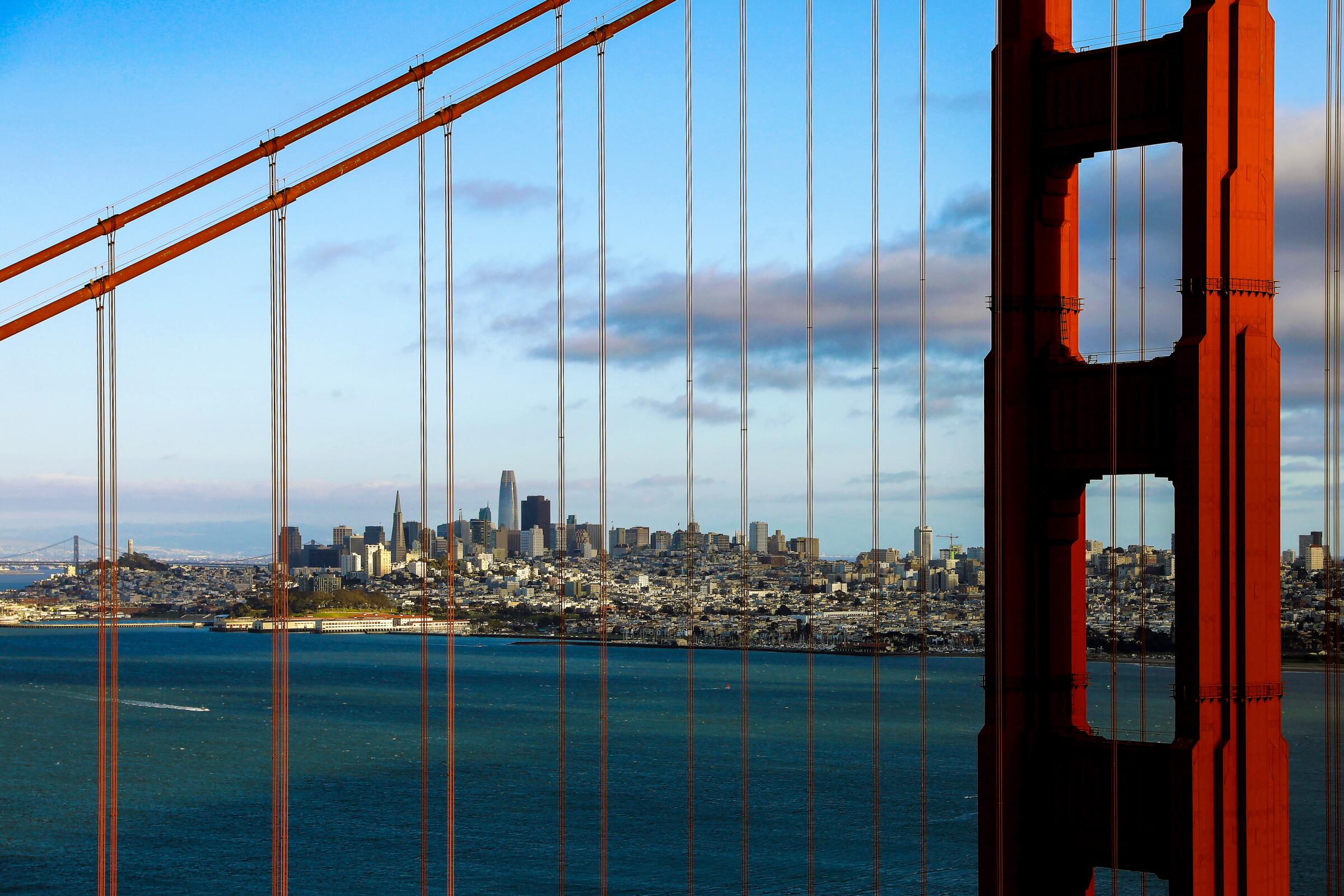
San Francisco, which depends on tourists the way the Golden Gate Bridge depends on towers and cables, is ready for you. Or almost ready.

With the city’s move into the “orange” tier of pandemic recovery on Tuesday, restaurants can open up to half of their indoor seating, a move that puts San Francisco a few weeks ahead of Southern California because of improved COVID-19 test numbers and vaccination rates. A visitor now can expect busier restaurants, revived museums, lower room rates and fewer amenities at hotels, a new Ferris wheel in Golden Gate Park, and a higher fisherman-to-tourist ratio than Fisherman’s Wharf has seen in generations.
But this picture also includes no working cable cars, a locked Coit Tower, ghostly silences among the downtown skyscrapers, fewer fancy food purveyors in the Ferry Building and an awkward pause at the entrance to restaurants as diners return.
“Would you like to sit indoors or out?” a host asked one diner at Gracias Madre restaurant on Mission Street. It was 48 degrees and damp.
“Outside,” the diner said. This is what every diner had said — seven tables occupied, all outside. Restaurants were allowed to seat customers indoors at 25% of capacity from March 3 until Tuesday, when the restriction was relaxed to 50%. Yet as server Korina Wilson said, “a lot of people don’t want to sit inside just yet.”
As for those cable cars, at least one of the city’s three lines is expected to start rolling in fall, and street cars could return to the Embarcadero and Market Street as soon as May.

Is it time to visit? That’s your call. As restrictions ease throughout the state, health officials in Sacramento still advise against vacations more than 120 miles from home. In L.A. County, public health officials still ask residents to defer travel. But these are now recommendations, not mandates.
Though the city’s hotels have been allowed to accommodate tourists since Jan. 28, roughly one-third were still closed as of mid-March.
Here are several voices from San Francisco on what they’ve seen and expect.
I was lucky to have a place where I could escape the living nightmare. My family owns a pearl farm on a tiny, remote atoll northeast of Tahiti.
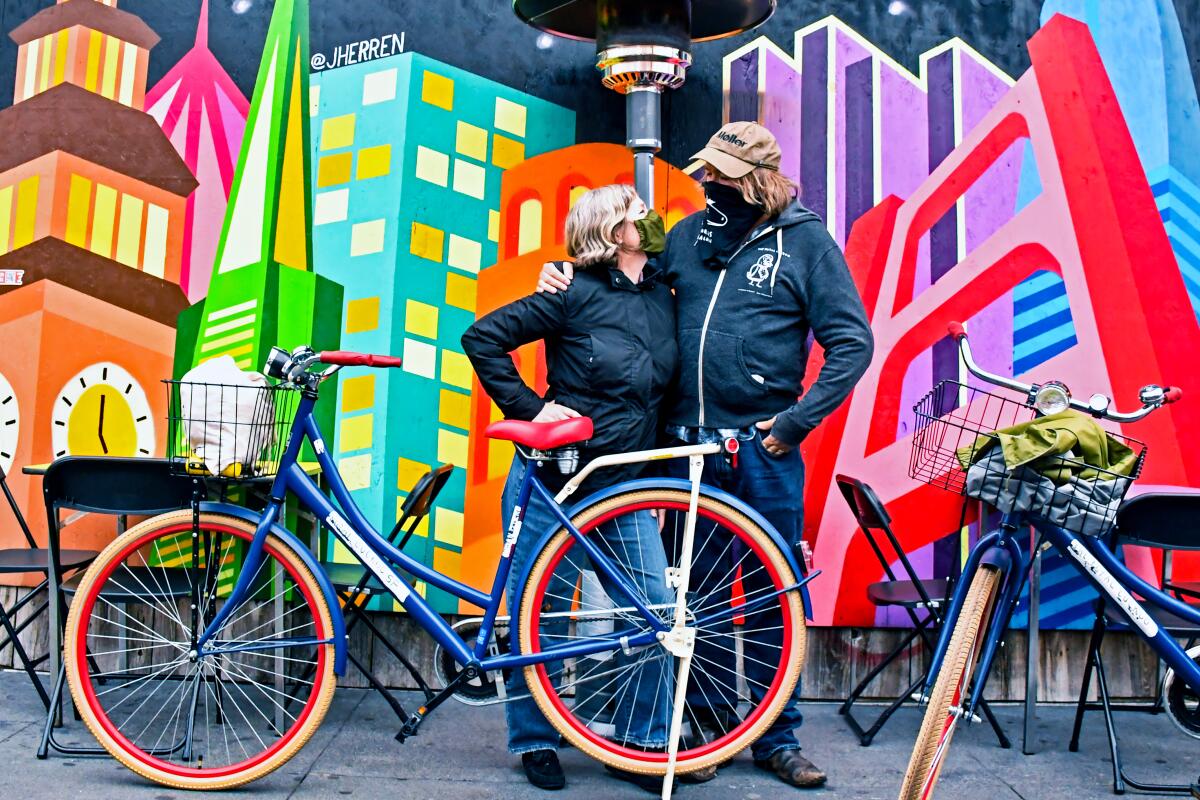
On a cloudy Tuesday afternoon in mid-March, Debbie Horn and her husband, Paul Miller, were biking on Valencia Street in the Mission District.
Said Miller: “There are so many more people riding bikes. We’re getting more like Copenhagen and Amsterdam.”
Said Horn: “You can people-watch more than ever.”
In Golden Gate Park, the SkyStar Ferris wheel reopened March 4, carrying passengers 15 stories above the de Young Museum (reopened March 6) and the California Academy of Sciences (reopened Wednesday). The Japanese Tea Garden is open to individuals, and City Guides volunteers are again leading walks.
Though shops and many hotels around Union Square are open, with others following soon, the square itself was so sleepy in mid-March that a midweek walker could hear birdsong and the distant voice of a ragged man asking for money — sounds that might have been drowned out two years ago by cable cars, buskers and other city clatter.
San Francisco lodging rates are “much less” than they were two years ago, said Joe D’Allesandro, chief executive of the San Francisco Travel Assn.
Rooms for less than $150 a night are common, but many hotel restaurants are closed and services are curtailed.
Yet the new energy is bittersweet. Because they have lived in the Mission District for years and co-own the nearby Royal Cuckoo Organ Lounge, Miller said he and his wife know that “even if you see a place that looks like it’s jamming, it’s still probably losing money.”
“Don’t be fooled,” Horn said. “Everyone is a year behind in their bills.”

The San Francisco Museum of Modern Art reopened March 7. A few days later, Chief Administrative Officer Noah Bartlett stood near the entrance, remembering the start of the pandemic a year ago.
“We assumed it was going to be six weeks,” he said. “So naive, right?”
Since then, Bartlett and the museum’s core employees have rescheduled exhibitions, rethought budgets and mapped “every surface the people would come in contact with,” including elevator buttons, now covered by NanoSeptic self-cleaning pads.
“We like to say that we’re one of the safest indoor experiences you can have. You and I can move through this building without touching anything,” Bartlett said.
Why hike in Los Angeles? Lots of reasons. Use our guide to navigate 50 trails in Southern California, plus tips on gear and treats for the trail.
But he also understands that the recovery might go slowly. The museum’s three restaurants remain closed. Moscone Center across the street, previously one of the busiest convention venues in the nation, is a vaccination site.
Before the pandemic, Bartlett said, up to 60% of the museum’s visitors were from outside the Bay Area, and daily attendance rarely fell below 2,000. For its grand reopening, the museum drew about 3,500 over two days.
“The energy has changed,” Bartlett said. “We’re going to remain in a depressed state, I think, probably for a few years,” Bartlett said. “It’s really accelerated our focus on local audiences.”

On its fifth floor, the museum will soon open an exhibition called “Contemporary Optics.” As an installer readied the galleries, Bartlett stepped onto the Oculus Bridge — the showcase walkway that hangs four floors above the museum lobby — and strode into artist Olafur Eliasson’s ”One-Way Colour Tunnel,” which sparkled like purple ice.
This, Bartlett said, is a silver lining: A visitor now “can really get the museum insider’s experience — time alone with artworks.”
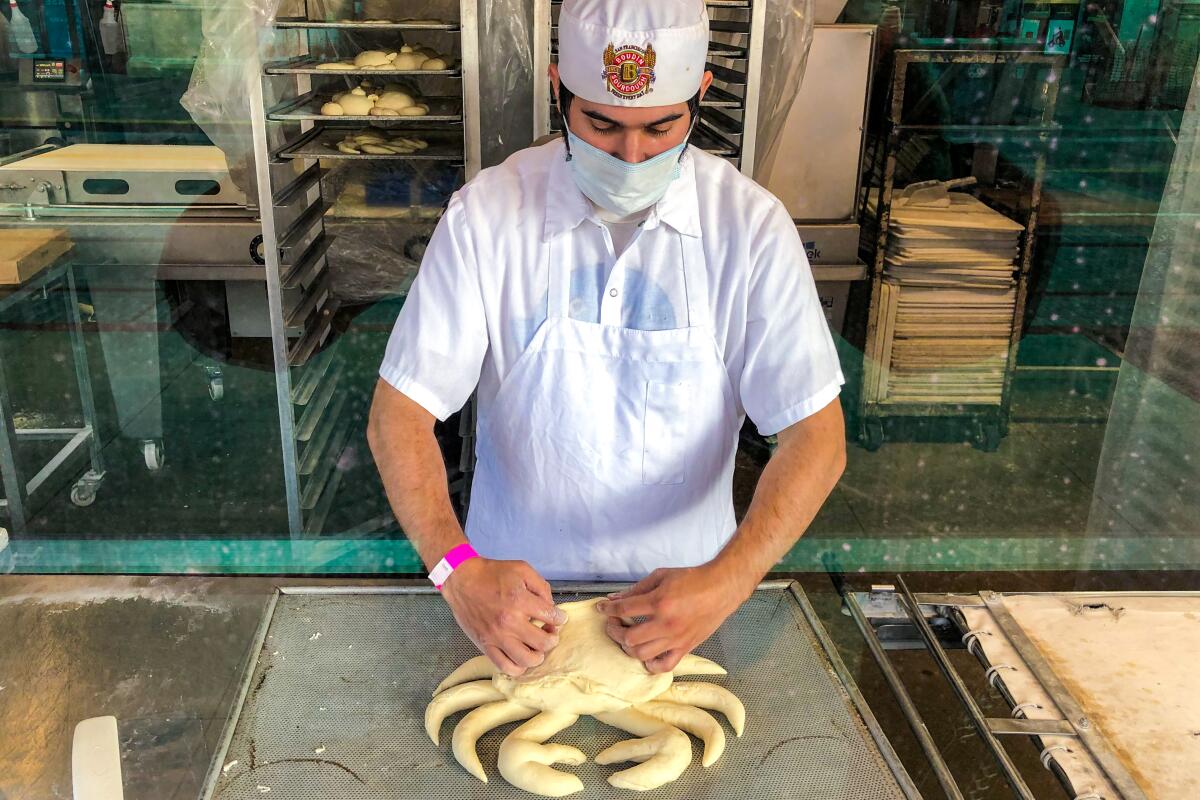
At Boudin Bakery at Fisherman’s Wharf, a baker stood in the picture window kneading dough into the shape of a crab. A few feet inside the open door, visitors Dakota Cooley and her wife, Amanda Cooley, were sitting down to breakfast.
“We came from Arizona, just traveling the safest way we know how. Which is driving,” Amanda said.
“It’s the perfect time to drive for somebody who doesn’t know this traffic,” Dakota said. “Nobody is stress-driving from work.”
Since arriving a week before, they’d admired a lot of churches and waterfront architecture, often from their car. It reminds them of Europe, Amanda said, and it’s worlds away from Arizona, “where a lot of people don’t want to wear masks.”
On neighboring blocks, the stores and restaurants of Pier 39 and Ghirardelli Square were open at reduced capacity. The Cooleys’ agenda: ride atop a double-decker tour bus and see about a cruise to Alcatraz.
Alas, they were a few days early for that. The former prison island, part of Golden Gate National Recreation Area, reopened at limited capacity on Monday, after the Cooleys were due home.
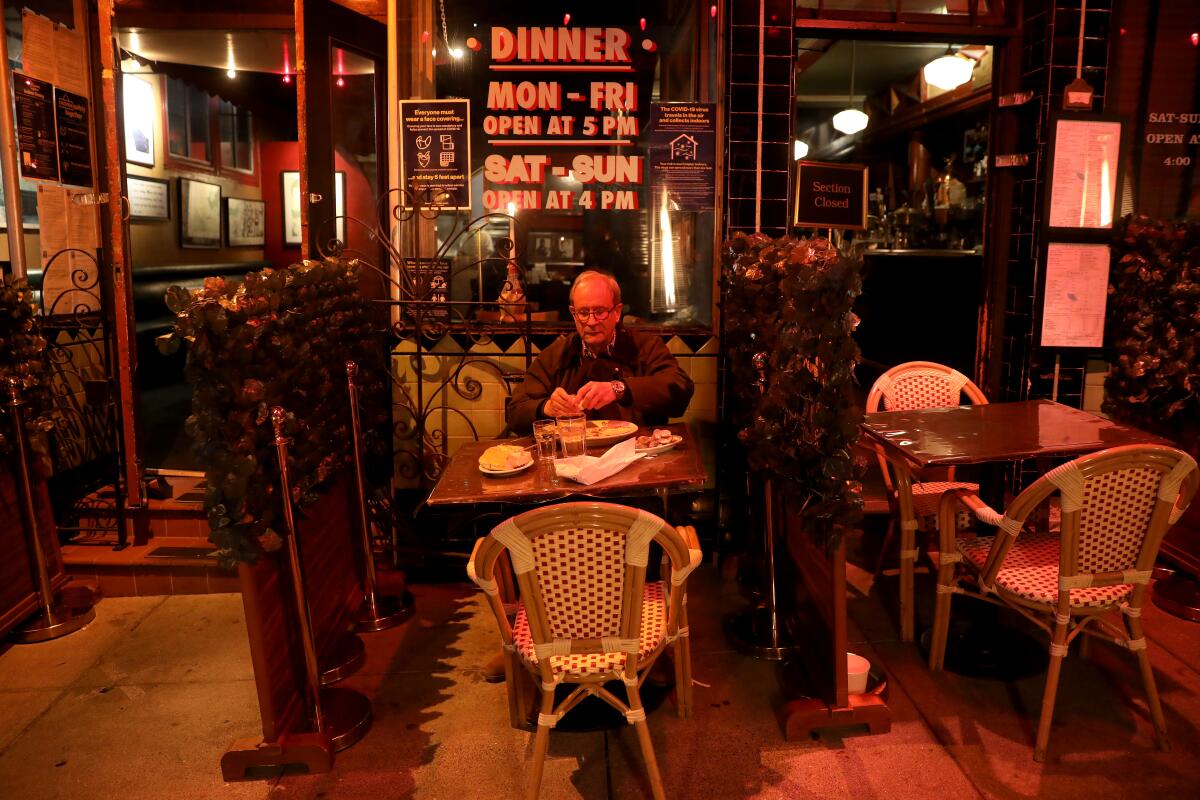
Sotto Mare restaurant stands on a short stretch of Green Street in North Beach that’s been a bright point in the pandemic. The street resounds with the noise of diners unwinding as several restaurants have grouped their outdoor tables.
“On the weekends, it can be a two-hour wait,” said manager Ria Azzolino Pesenti. More than 1,700 businesses have signed on to the city’s Shared Spaces program, which allows dining and retail to expand onto sidewalks, parking lots and parking lanes. Many restaurants are upgrading their patios to last longer and look better.
“We’ve now seen what’s possible,” Mayor London Breed tweeted March 12. “I’m introducing legislation to make the program permanent.”
Claremont, on the eastern edge of L.A. County, is home to historic architecture along its streets and on the campuses of the Claremont Colleges.
Besides the struggle to keep tables six feet apart, Pesenti and her team juggle challenges with delivery services and plexiglass dividers (which everyone likes, so the restaurant will keep them after the pandemic). Then there’s the cioppino question.
Tourists, who used to be half of the restaurant’s business, almost always order it because it’s Sotto Mare’s signature dish. Locals, who have kept the place alive for the last year, often choose sand dabs, scallops or the fish of the day.
How fast will tourists return and where will they sit? It’s impossible to know. But many local Sotto Mare customers are ready to come out of the cold. March 8, Pesenti said, “was the first night that we had more people who wanted to wait for the inside than sit outside.”
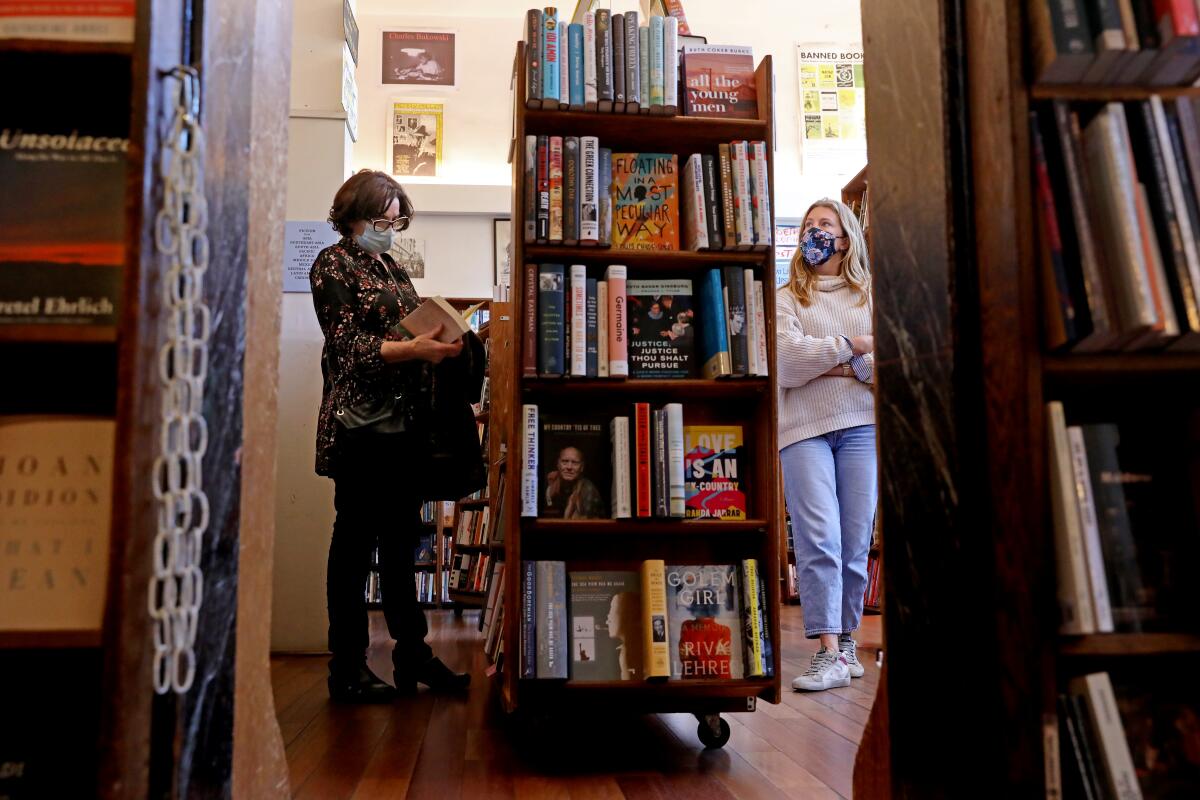
On the wall of City Lights bookshop, cofounder Lawrence Ferlinghetti hand-lettered a sign several decades ago: “Have a seat and read a book.” It’s a grand idea, but a thorny one for manager Andy Bellows.
Ferlinghetti, the Beat culture hero who died at age 101 in February, believed that people should be able to sit and read for hours without buying anything. Accordingly, the store had about 20 seats on its three levels. But as the store struggled with pandemic limits and a roughly 60% drop in sales, many things had to change.
City Lights gets so much business from out-of-towners that it typically sells more books in July and August than it does in November and December. In 2020, there was almost none of that. The temporary closures of Vesuvio Cafe next door and Specs’ bar across the street didn’t help either. The store’s future looked iffy until a GoFundMe campaign raised more than $510,000.
“We were floored. Floored,” Bellows said.
The store has kept its staff, Bellows said, but now opens for eight hours a day instead of 14. Customers (no more than 20 at once) enter through one door, sanitize hands (so they can handle books freely) and exit through the door by the register. Eight seats remain, along with Ferlinghetti’s sign.
A new website is intended to boost online sales. And with one employee at the entrance, a second at the exit and another roaming the shop, Bellows said, “we have more people on the floor than we ever have, and there are benefits to that. More interaction with customers.”
And there’s this comforting news: Vesuvio was to reopen on Thursday. No word yet on a timetable for Specs’.
Sign up for The Wild
We’ll help you find the best places to hike, bike and run, as well as the perfect silent spots for meditation and yoga.
You may occasionally receive promotional content from the Los Angeles Times.